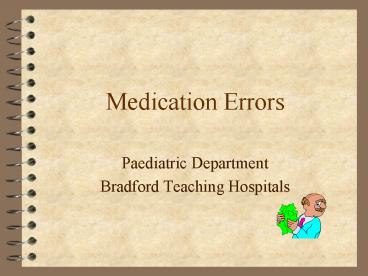Medication Errors - PowerPoint PPT Presentation
1 / 14
Title:
Medication Errors
Description:
Medication Errors in Paediatrics. Background. Practical examples (workshops) ... Lists of commonly used drugs in Paediatrics on ward trolleys in the Children's ... – PowerPoint PPT presentation
Number of Views:343
Avg rating:3.0/5.0
Title: Medication Errors
1
Medication Errors
- Paediatric Department
- Bradford Teaching Hospitals
2
Medication Errors in Paediatrics
- Background
- Practical examples (workshops)
- Case studies
- Key messages
3
Background
- Medication errors (prescribing, dispensing and
administering) are very common in Paediatrics and
Neonates - Medication errors are the commonest adverse
incidents reported in our Department ( 100
reported between April and October 2005)
4
(No Transcript)
5
Medication Errors
- Prescription
- Wrong dose
- Illegible
- Signature not identified
- Wrong drug
- Wrong concentration
- Administration
- Wrong patient
- Wrong drug
- Wrong dose
- Wrong infusion/ rate
6
Medication Errors During Hospital Admission
- Can occur at any of the following stages
- Prescribing by GP or other health professional in
the community - Dispensing from local chemist
- Administration by parents/ patients
- Prescribing in hospital by doctor
- Dispensing from Hospital Pharmacy
- Administration by Nursing staff
7
Possible Explanations
- Lack of experience (children are not small
adults!!) - Lack of training/ induction
- Lack of robust systems to prevent errors
- Writing unclear/ incomplete illegible
- No double checking
- Working pressures/ lack of supervision
- Medical records/ clinic letter not available
8
Possible Explanations (cont)
- Some drugs have different interactions and side
effects in children. - Drug allergies are not that uncommon in children
(possibly on the increase). - Drug doses in children should be calculated based
on weight and sometimes on body surface area.
9
Key Messages/ Lessons Learnt
- Robust induction of new staff
- Competence-based training
- Systems to report errors and learn lessons
- Systems to prevent errors
- Dissemination of lessons learnt
- Continuous developing of systems to prevent errors
10
Systems to Report Errors
- Incident reporting
- Regular prescription audits
- Regular Risk Management Meetings to discuss errors
11
Systems to Prevent Errors
- Regular ward rounds by Paediatric Pharmacists
- 10 Steps to Safe Prescribing in Paediatrics
- 10 Steps to Safe Prescribing for Neonates
- Copies of BNF for Children in all clinical areas
- Lists of commonly used drugs in Paediatrics on
ward trolleys in the Childrens wards (surgical
medical) and on the Intranet
12
Dissemination of Lessons Learnt
- Multidisciplinary Clinical Governance Meetings
- Monthly Clinical Governance Newsletter
13
Clinical Governance Newsletter
14
New Systems
- Involve parents of children with chronic diseases
in safe prescribing - Specialist Nurse-led prescribing (Asthma ,
Diabetes, Palliative Care) - Develop 10 Steps to Safe Drug Administration
- Future electronic prescribing
- Community- PACE Event on Patient Safety































